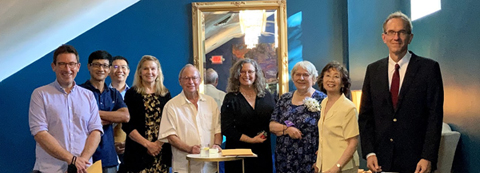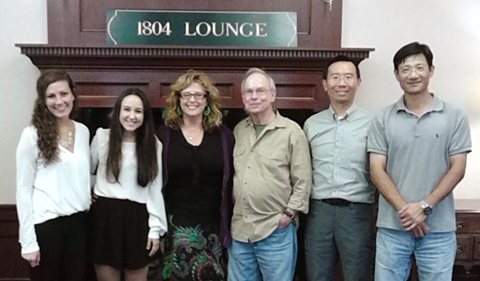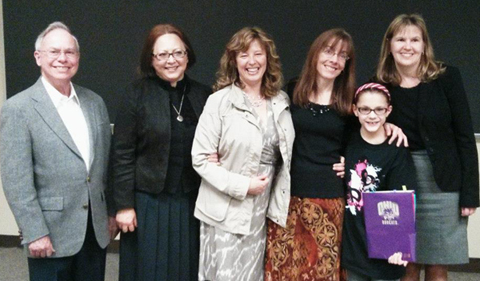
Faculty celebrate the 25th anniversary of the Institute for the Empirical Study of Language with Vice President for Research and Creative Activity Dr. Joseph Shields (far right) Faculty, from left: Dr. Mark Gibson, Dr. Li Xu, Dr. Chao-Yang Lee, Dr. Sally Marinellie, Dr. Danny Moates, Dr. Emilia Alonso-Sameño, Dr. Zinny Bond, and Dr. Liang Tao.
The Institute for the Empirical Study of Language is marking its 25th anniversary this fall by celebrating the collaboration and camaraderie of a small group of faculty and their impact on language research at Ohio University.
IESL is an interdisciplinary program with faculty and students from two different colleges and from three continents: North America, Europe and Asia. IESL faculty are committed to scholarship and to providing support to each other and training to their students.
“We have brought together faculty from four disciplines to conduct language research in an interdisciplinary setting. Doing so has opened us to how language research is conducted in these other disciplines and broadened our approach to how we conduct research as an institute,” said Dr. Emilia Alonso-Sameño, director of the institute and professor of Spanish in the Modern Languages Department.
Permanent faculty members and student members of the institute come from the Division of Communication Sciences and Disorders and the School of Rehabilitation and Communication Studies in the College of Health Sciences and Professions and the departments of Linguistics, Modern Languages, and Psychology in the College of Arts & Sciences. Adjunct members, who collaborate with OHIO members in research on language processes, have appointments in academic institutions such as Denison University, Universidad Complutense de Madrid, Universidad de Navarra, and Jawaharlal Nehru University.
“The IESL has been a professional life-saving haven for me and for other junior faculty members, whether continuing or adjunct. It is the ideal forum for discussing ideas, proposing new collaborative research, and engaging with other members’ projects. It is also a nurturing environment for developing mentoring relationships and supporting junior faculty through the tenure process,” Alonso-Sameño said.
“The members of IESL are open to lighter fare, too. Most of our meetings have presentations of someone’s research, and these broaden our own experience and sometimes prompt new research ideas. From time to time, though, we slip in a party, maybe to celebrate the end of the semester. The time is not wasted.”

IESL faculty and student members at a social gathering in 2014 [from left: Ms. Anita Belfiore, Ms. Ariadna Sánchez-Hernádez, Dr. Emilia Alonso-Sameño, Dr. Danny Moates, Dr. Chao-Yang Lee and Dr. Li Xu]
“We have engaged with the campus faculty in a variety of ways. We organized a conference on first and second language acquisition and learning, which attracted many public-school teachers and clinicians. We hosted several Kennedy speakers, bringing in researchers of the caliber of David Pisoni (Indiana University) and alumnus John Locke (Lehman College). We sponsored international guest speakers, like Jane Arnold (Universidad de Sevilla, Spain) to give a plenary at an ongoing CALL conference,” Alonso-Sameño noted.

IESL Faculty and guests with speaker Dr. Mary Zampini (LeMoyne College) in April 2013 [from left: Dr. Danny Moates, Dr. Ludmila Marchenkova, Dr. Emilia Alonso-Sameño, Dr. Mary Zampini and her daughter, and Dr. Sally Marinellie]
Making strong interdisciplinary connections
Starting an interdisciplinary institute with a small number of faculty required a lot of perseverance.
The first challenge was communication.
“We were all competent in our own disciplines, but we had to learn what the other disciplines could bring to a project. If reps from three disciplines wanted to do a project together, each had to educate the other two about what strengths his or her discipline could bring to the project. Was one strong on materials, another strong on methodology, another familiar with a really interesting problem in the field of language study? We couldn’t learn everything about another discipline, so our rep had to pick out the parts relevant to the developing study and explain them to the others. It’s time-consuming, but it can also open up an interesting idea that a single member would never have considered,” Alonso-Sameño said.
A second challenge was the creation of a certificate program for undergraduates.
“We thought undergraduates in language study had little chance to do empirical research, and they needed that experience to get admitted to graduate study. We designed a certificate program that combined several language-related courses with hand-on research projects with three of our faculty from at least two different areas, say linguistics and Spanish. It finished with a thesis project. That gave them a lot of research experience, and we believed that would give them an edge in graduate applications. It took over 10 years to get that certificate approved by the University Curriculum Council. The certificate has evolved now to be more in tune with other certificate programs offered on campus. Students do not need to complete a thesis, but a ‘publishable’ manuscript. We have also developed a certificate program for graduate students,” Alonso-Sameño added.
Colleagues around the world
Over the years, IESL had a number of undergraduate students who successfully completed the certificate program and went on to graduate school. One of them was Alba García-Alonso, whose thesis project used eye-movement technology to study reading strategies among English learners of Mandarin Chinese. She was accepted into the master’s program in applied linguistics at Penn State University.

Alba García-Alonso celebrates defending her thesis [from left: Dr. Emilia Alonso-Sameño, Alba García-Alonso and Dr. Scott Jarvis]
Another student from the program was Mark Gibson, currently serving as a visiting research scholar with the institute this semester. He completed his B.A. and M.A. in Spanish here at OHIO, went on to complete a Ph.D. in Linguistics from Universidad Complutense de Madrid, and is currently an assistant professor of linguistics at Universidad de Navarra in Spain.
Both Sánchez-Hernández and Gibson are currently adjunct institute members.
For further information concerning the institute, contact Alonso-Sameño at markse@ohio.edu.


















Comments